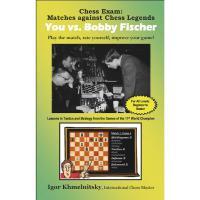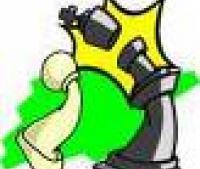
Book Review - Chess Exam: Matches against Chess Legends, You vs. Bobby Fischer
Chess Exam: Matches against Chess Legends, You vs. Bobby Fischer
IM Igor Khmelnitsky
2009 IamCoach Press
190 pages
Hello chess enthusiasts and readers! I have just finished working through my copy of Chess Exam: Matches against Chess Legends, You vs. Bobby Fischer by IM Igor Khmelnitsky, who you may know from some of his Chess Mentor courses on Chess.com. I would like to provide some thoughts and insights into his new book just published in December of 2009.
My first impressions after just finishing the book - it was an enjoyable and challenging learning experience!
This book can be broken down into two parts mainly. The first being the numerous positions (exams) where you are asked to evaluate and answer various questions about the positions. Then the second is the evaluation/"coaching" phase where you evaluate your answers from the positions (exams) and then get feedback on how to further improve the weaker parts of your games based on the quiz results.
Let us examine the first part of the book, being the positions/exams. The book starts off with 20 warm up exercises, then the main 60 exam exercises to "evaluate" your chess, and then a few more problems towards the end of the book to bring the total to 94 chess exercises, enough for any chess enthusiast.
Below I have included one of the warm up exercises just to give a taste of what you will find in this book:
The solution to this warm up exercise can be found at the bottom of this article.
Now back to the discussion of the book. The above chess position is just one of many you will find throughout the book. And in each and every position you are playing as the opponent of Fischer so it is as if you are playing one of the greats in chess history! The positions range from attacking to defense to endgames to strategy and so on. As I went through the book I realized that Khmelnitsky put in a lot of work to pick quality chess positions which will test all aspects of your game.
Once you have worked through the main chess exam section you can take your answers and get a full detailed evaulation and rating of all areas of your chess game along with an overall rating. The evaluation section will give you feedback on 13 different aspects of your chess game listed below:
- Middlegame
- Endgame
- Calculation
- Strategy
- Tactics
- Attack
- Counterattack
- Defense
- You are Better
- Equal
- You are Worse
- No Sacrifice
- Sacrifice
With the evaulation broken down into so many different sections you can easily realize which parts of your chess game are already strong and what still needs work. Khmelnitsky does a great job with the various charts and statistical analysis to provide you with a clear and accurate assessment of your overall chess game.
This is really the best part of the book. Owning a copy of this book is just like having your own personal chess coach. And generally 1 lesson with a hired chess coach would cost the same price as the whole book! And in this book you get a self examination and detailed assessment and analysis of your chess which could take multiple lessons with a hired coach to accomplish.
And even after the final evaluation and assessment of your answers from the main examination there are some nice little sections included by Khmelnitsky at the end of the text such as "What is the next step?" and "Training Tips and Recommendations" both sections discussing what you should be looking to do to take the next step with your chess.
Overall a great piece of work by IM Igor Khmelnitsky here, which I highly recommend for anyone whose aim is to get a detailed assessment of their chess game to know where they stand and find out their strengths and weaknesses. Although I must warn this is not the text for anyone who is looking to have their ego stroked as this book will give you a fair and honest assessment of your chess which is what an improving chess player should want.
Solution to the sample warm up exercise:
This question might seem easy - the g3 pawn is in serious trouble and there is only one way to defend - via an ugly looking 37. Nh1. Busguier did play it but only lasted 4 more moves. He resigned after 37...Rc1! (nearly paralyzing White) 38. Rf2? [slightly better is 38. Qg4 R8c7] 38...g4!-+ 39. Qxg4 Qxg4 40. pxg4 Kg7 [clearing the path to h8 for the c8 Rook] 41. Rf5 Rxh1+ [42. Kxh1 Rc1+ 43. Kh2 pxg3+ 44. Kh3 Rh1#] 0-1 Bisguier, Arthur - Fischer, Robert, USA (Ch), New York, 1956. A much better strategy would have been to ignore the threat to the g3 pawn. Then, the best move is 37. Ng4!. After 37...pxg3+ 38. Rxg3! Bxg3+ [38...Bf4 39. Qxd4=] 39. Kxg3=, White has Knight + pawn for the Rook. Also, White has nice targets, as the Black King is weak and so are the Black pawns. The position is dynamically balanced. Practice it against a friend or computer.






